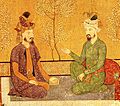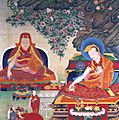Mongols facts for kids
  |
|
| Total population | |
|---|---|
| (10 million) | |
| Regions with significant populations | |
| Mongolia, China, Russia | |
| Languages | |
| Mongolic languages | |
| Religion | |
| Predominantly Tibetan Buddhism and Shamanism with minorities of Christianity, Islam, Atheism | |
| Related ethnic groups | |
| Khalkha, Daurs, Buryats, Evenks, Dorbots, Kalmyks, Oirats, Chakhars, Tumeds, Ordoses, Bayad, Dariganga, Urianhai, Uzemchin and Zakhchin. |
The Mongols are a group of people who share a common history and culture. They mostly live in Mongolia, China, and Russia. Many Mongols speak a Mongolic language.
The name Monggol means "the invincible ones" in the Tungusic languages. It first referred to a small tribe near the Onon River. In the 1200s, a great leader named Genghis Khan united many tribes. After this, "Mongols" became a name for all these united groups.
Contents
Beliefs of the Mongols
The early Mongols believed in many gods and spirits. They thought good and evil spirits controlled the world. They also believed in one very important god. This god was called Tengri (TENG gree). He was known as "the great god of heaven." Mongols lived in fear of spirits. They hoped the spirits would give them blessings.
Every traditional Mongol home, called a yurt, had small idols. These idols were made of felt. Women and girls made them at sewing parties. Mongols believed these idols protected their families and animals. Before meals, they would offer food and drink to the idols. They also prayed to them.
Shamans and Their Role
Some men, called shamans (SHAH muns), were thought to have power over spirits. Shamans were the priests of the old Mongol religion. This religion is called shamanism (SHAH muh NIZ um). Shamans were like medicine men and witch doctors. They used a special language during their magical rituals. Mongols often asked shamans for advice before making big choices.
Other Religions in the Empire
Later, the Mongol Empire grew very large. It included many people with different religions. Some of these religions included Christianity. The most important Christian group was the Nestorian Church. These Christians were named after Nestorius, a bishop from Constantinople.
Related pages
Images for kids
-
Asia in 500, showing the Rouran Khaganate and its neighbors, including the Northern Wei and the Tuyuhun Khanate, all of them were established by Proto-Mongols
-
Mongol man with a hat, Yuan dynasty
-
Yuan dynasty Mongol rider
-
A portrait of Kublai Khan by Araniko (1245–1306)
-
Mongol huntsmen, Ming dynasty
-
A Dzungar soldier called Ayusi from the high Qing era, by Giuseppe Castiglione, 1755
-
The Battle of Oroi-Jalatu in 1755 between the Qing (that ruled China at the time) and Mongol Dzungar armies. The fall of the Dzungar Khanate
-
Khorloogiin Choibalsan, leader of the Mongolian People's Republic (left), and Georgy Zhukov consult during the Battle of Khalkhin Gol against Japanese troops, 1939
-
Mongolian President Tsakhiagiin Elbegdorj (right)
-
A Mongolic Ger
-
Buddhist temple in Buryatia, Russia
-
Mural of a Mongol family, Yuan dynasty
-
This map shows the boundary of the 13th-century Mongol Empire and location of today's Mongols in modern Mongolia, Russia and China.
-
Mongol Empress Zayaat (Jiyatu), wife of Kulug Khan (1281–1311)
-
The 4th Dalai Lama Yonten Gyatso
-
Dolgorsürengiin Dagvadorj became the first Mongol to reach sumo's highest rank.
-
Daur Mongol Empress Wanrong (1906–1946), also had Borjigin blood on maternal side.
See also
 In Spanish: Mongoles para niños
In Spanish: Mongoles para niños









































